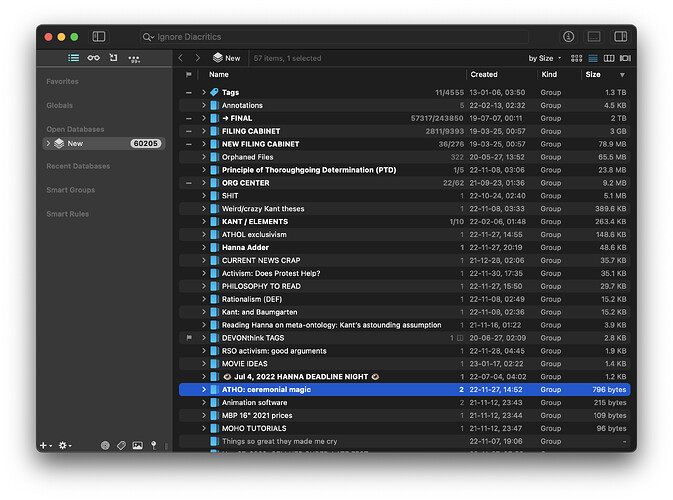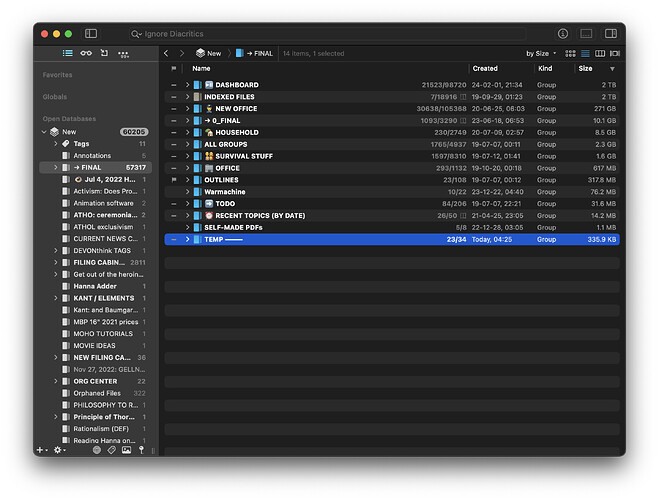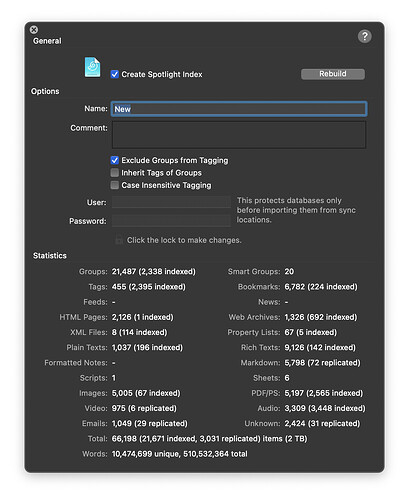Hello DEVONians. I am come again with another heartache.
I’ve seen similar posts about this problem and know what Jim will ask so here’s the info:
- System & Dir Info:
MBP 16” 2021 (M1) • macOS 12.7.6
RAM: 16 GB
HDD: 994 GB
DEVONthink version: 3.9.14
DB size: 45.96 GB
DB file location: ~/Databases/New.dtBase2 - Indexing:
- I have placed the dozen Finder folders I index in a Group called INDEXED FILES, which is 2 TB as you can see in the images. The other the two other 2-TB Groups I have are 2 TB because each contains a Replicant of INDEXED FILES.
- These indexed folders are —
- All in my internal HDD home folder.
- The include the Attachments folder from ~/Documents/Bookends plus 21 others. (Useful fact: Each Finder folder that is indexed starts with the string DT_IDX [dir name].)
- I also have indexed some large Finder folders on external HDDs, as you can see.
Image of the DB’s TOP LEVEL —
(Oh, I see above that the Tags Group on top is huge. Or is it? It’s just a bunch of Replicants, right? But maybe it’s still RAM-taxing? Should I kill it (assuming it’s easy to re-create o demand)?
Image of inside the Group that holds the INDEXED FILES Group:
Here are my two questions —
Q1: DT uses 8.8 GB RAM and I need to Force Quit
I can’t use DT anymore because its RAM usage is so big I have to Force Quit within a few minutes. When I launch DT, the used RAM is immediately 6 GB. After a few clicks, 8.8 GB. Then I get a warning, and have to Force Quit.
What’s the best way to stop this? Kill the huge HDD indexings?
If you say, “Split your DT DB into sub-DBs,” then I’m worried. There’s lots of Replicants spread throughout.
But if you insist on splitting, what would be your strategy? Is there a KIND of record that you’d move off-shore? Would it be the indexed ones?
Has anyone else had the Force Quit problem before, and solved it? What did you do?
Here is a troublesome related question:
Q2: Organization anxiety
My DT world is like another Finder. But I also have a Finder. Half of my total content is in DT; the other half, in Finder. Has anyone here thought, “It’s time for me to get my Finder organized. I’ll implement Johnny Decimal or something like that and then the Finder will be useful again?”
I mention this because I’m the guy who has been using DT as an outliner for 15 years. If I try to stop the Force Quit problem by offloading as much of my DT stuff into a finally-organized Finder, I’m in for some serious problems, since most of the value-added I produce is in Unsorted lists of Groups. These won’t make it across.
My two problems—(a) preventing the Force Quit and (b) finally being an adult about my Finder—are related but pretty different. The second one is deep and so maybe should be ignored. I only mention it because I’m guessing that someone will say, “Reduce DB size by offloading as many records as possible into the Finder, specifically the [by kind? by size? by logic? by workflow?] records.”
Thanks in advance.


